
http://picasaweb.google.com/sufimeditationcenter/Islamic/photo#5074618782749097810
Historically speaking, the Naqshbandi tariqat can be traced back to the first of the Rightly-Guided Caliphs, Abu Bakr as-Siddiq (r), who succeeds the Prophet (s) in his knowledge and in his role of guiding the Muslim community. Allah said in the Holy Qur'an "He was the second of two in the cave, and he said to his friend: 'do not be sad, for God is with us'" [9:40]. Of him the Prophet (s) said, "If I had taken to myself a beloved friend, I would have taken Abu Bakr as my beloved friend; but he is my brother and my companion.

"
What distinguishes the Naqshbandi school from other Sufi orders was the fact that it took its foundations and principles from the teachings and example of six bright stars in the firmament of the Prophet (s). These great figures were: Abu Bakr as-Siddiq, Salman al-Farisi, Jacfar as-Sadiq, Bayazid Tayfur al-Bistami, cAbdul Khaliq al-Ghujdawani, and Muhammad Baha'uddin Uwaysi al-Bukhari, known as Shah Naqshband--the eponymous Imam of the tariqat.

Behind the word "Naqshband" stand two ideas: naqsh which means "engraving" and suggests engraving the name of Allah in the heart, and band which means "bond" and indicates the link between the individual and his Creator. This means that the Naqshbandi follower has to practice his prayers and obligations according to the Holy Qur'an and the Sunnah of the Prophet (s) and to keep the presence and love of Allah alive in his heart through a personal experience of the link between himself and his Lord.

Besides Abu Bakr as-Siddiq, who are these stars in the firmament of the Prophet (s)? One of them was Salman al-Farisi (r). His origin was Isfahan in Persia and he was the one who advised the Muslims to dig a trench in the battle of Ahzab. After the Muslims seized al-Mada'in, the capital city of Persia, he was made Prince and governor of that city and remained there until his death.

Another star was Jacfar as-Sadiq. A descendant of the Prophet (s) on his father's side and of Abu Bakr (r) on his mother's, he rejected all positions of honor in favor of retreat and spiritual learning and practice. He was called "The Inheritor of the Prophetic Station (Maqam an-Nubuwwa) and the Inheritor of the Truthful Station (Maqam as-Siddiqiyya).
The oldest recorded occurrence of the term safa was in reference to his
The Hajj (Arabic: حج, transliteration: Ḥaǧǧ), that is pilgrimage to Mecca (Makkah), is the largest annual pilgrimage in the world.[1] It is the fifth pillar of Islam, an obligation that must be carried out at least once in their lifetime by every able-bodied Muslim who can afford to do so. It is a demonstration of the solidarity of the Muslim people, and their submission to God.[2]
The pilgrimage occurs from the 6th to the 12th day of Dhul Hijjah, the 12th month of the Islamic calendar. Because the Islamic calendar is a lunar calendar, the event cannot be pegged to the Gregorian calendar, whose (solar) year is eleven days longer. In 2007, Hajj took place from December 17 to December 21.
The Hajj is associated with the life of Muhammad, but the ritual of pilgrimage to Mecca predates Islam, and was considered ancient even during his lifetime in the 7th century. Many Muslims believe that it goes back to the time of Abraham in 2000 BCE. Pilgrims would join processions of tens of thousands of people, who would simultaneously converge on Mecca for the week of the Hajj, and perform a series of rituals. Each person would walk counter-clockwise seven times about the Kaaba, the cubical building towards which all Muslims pray, kiss the sacred Black Stone on its corner, run back and forth between the hills of Al-Safa and Al-Marwah, drink from the Zamzam Well, go to the plains of Mount Arafat to stand in vigil, then proceed to Muzdalifah to gather pebbles, which they would throw at a rock in Mina to perform the ritual of the Stoning of the Devil. The pilgrims would then shave their heads, perform an animal sacrifice, and celebrate the three day global festival of Eid ul-Adha.[3][4][5]
As of 2007, an estimated two million pilgrims participate in this annual pilgrimage.[6] Crowd-control techniques have become critical, and because of the large numbers of people, many of the rituals have become more stylized. It is not necessary to kiss the Black Stone, but merely to point at it on each circuit around the Kaaba. Throwing pebbles was done at large pillars, which for safety reasons were in 2004 changed to long walls with catchbasins below to catch the stones. The slaughter of an animal can be done either personally, or by appointing someone else to do it, and so forth.[7] But even with the crowd control techniques, there are still many incidents during the Hajj, as pilgrims are trampled in the crush, or ramps collapse under the weight of the many visitors, causing hundreds of deaths. The Kingdom of Saudi Arabia's Ministry of Hajj has a website, with the message, "Be peaceful, orderly and kind. No crushing."[8]
Pilgrims can also go to Mecca to perform the rituals at other times of the year. This is sometimes called the "lesser pilgrimage", or Umrah. However, even if they perform the Umrah, they are still obligated to perform the Hajj at some other point in their lifetime.
One can also perform the Hajj in the virtual reality game Second Life. The area which has been named Mecca was bought by the Egyptian owned Islam Online where both Muslims and non-Muslims alike may perform most rituals which are undertaken during the Hajj. It must be noted that according to some Muslim religious authorities, performing virtual Hajj is an educational exercise only, and is not an acceptable substitute for fulfilling the obligation of performing Hajj in real life.[9]
Part of a series on
Islam
Beliefs
Allah · Oneness of God
Muhammad · Prophets of Islam
Practices
Profession of Faith · Prayer
Fasting · Charity · Pilgrimage
History & Leaders
Timeline of Muslim history
Ahl al-Bayt · Sahaba
Rashidun Caliphs · Shi'a Imams
Texts & Laws
Qur'an · Sunnah · Hadith
Fiqh · Sharia
Kalam · Tasawwuf (Sufism)
Major branches
Sunni · Shi'a
Culture & Society
Academics · Animals · Art
Calendar · Children · Demographics
Festivals · Mosques · Philosophy
Politics · Science · Women
Islam & other religions
Christianity · Jainism
Judaism · Sikhism
See also
Criticism of Islam · Islamophobia
Glossary of Islamic terms
Islam Portal v • d • e
Contents
* 1 History
o 1.1 Incidents during the Hajj
* 2 Preparations
* 3 Rites
o 3.1 Umrah
o 3.2 Arafat
o 3.3 Muzdalifah
o 3.4 Ramy al-Jamarat
o 3.5 Eid ul-Adha
o 3.6 Tawaf az-Ziyarah
o 3.7 Tawaf al-Wada
o 3.8 Journey to Medina
* 4 See also
* 5 Notes
* 6 References
* 7 Further reading
* 8 External links
o 8.1 Arabic pronunciation
History
The Hajj was based on a pilgrimage that was ancient even in the time of Muhammad in the 7th Century. According to Hadith, elements of the Hajj trace back to the time of Abraham, around 2000 BC, and it is believed that Prophet Abraham was ordered by God (Allah) to leave his son Ismael and his wife in the desert. The wife agreed to the orders of Allah and so did Prophet Abraham.While Abraham's wife ran back and forth seven times searching for water for her son Ismael, he started to cry and he hit the ground with his feet and the water of the Zam Zam started coming up from under his feet and that is how the Zam Zam well came to be. Each year tribes from all around the Arabian peninsula would converge on Mecca, as part of the pilgrimage. The exact faith of the tribes was not important at that time, and Christian Arabs were as likely to make the pilgrimage as the pagans.[10] Muslim historians refer to the time before Muhammad as al-Jahiliyah, the "Days of Ignorance", during which the Kaaba contained hundreds of idols representing totems of each of the tribes of the Arabian peninsula. The idols represented multiple faiths, from pagan gods to symbols of Jesus, Mary, Hubal and Allah .[11]
Muhammad was known to regularly perform the Umrah, even before he began receiving revelations.[3] Historically, Muslims would gather at various meeting points in other great cities, and then proceed en masse towards Mecca, in groups that could comprise tens of thousands of pilgrims. Two of the most famous meeting points were in Cairo and Damascus. In Cairo, the Sultan would stand atop a platform of the famous gate Bab Zuwayla, to officially watch the beginning of the annual pilgrimage.[12]
In 632 AD, when Muhammad led his followers from Medina to Mecca, it was the first Hajj to be performed by Muslims alone, and the only Hajj ever performed by Muhammad. It was at this point that the Hajj became one of the Five Pillars of Islam. The Kaaba had been cleansed of the previous idols, and Muhammad ordained it as the house of God.[13]
Incidents during the Hajj
Main article: Incidents during the Hajj
There have been many incidents during the Hajj that have led to the loss of many hundreds of lives. The worst of these horrific incidents have usually occurred during the Stoning of the Devil ritual. During the 2006 Hajj on January 12, 362 pilgrims died. Tramplings have also occurred at the stage known as the sa'i, when pilgrims try to run but can only walk between two hills known as As-Safa and Al-Marwa. In 2006 there were some 600 casualties among pilgrims performing the Hajj.
The Saudi Government is often criticised for not being proactive in providing facilities and infrastructure for the annual pilgrimage, and many measures are put in place in response to annual catastrophes.
Preparations
See also: Ihram
Pilgrims generally travel to Hajj in groups, as an expression of unity. Some airlines have special package holidays for Muslims going to Mecca. And now ships have also taken the job of taking the pilgrims to Mecca so they can perform Hajj.
During the Hajj, male pilgrims are required to dress only in a garment consisting of two sheets of white unhemmed cloth, with the top draped over the torso and the bottom secured by a white sash; plus a pair of sandals. Women are simply required to maintain their hijab - normal modest dress, which does not cover the hands or face.[7]
The Ihram clothing is intended to show the equality of all pilgrims in the eyes of Allah, symbolizing the idea that there is no difference between a prince and a pauper when everyone is dressed equally. The Ihram also symbolizes purity and absolution of sins. A place designated for changing into Ihram is called a miqat.
While the pilgrim is wearing the Ihram, they cannot shave, clip their nails, wear deodorant or perfume. They may not swear or quarrel, kill any living thing, or engage in sexual intercourse.
An invocation, known as the talbiya (labaik allahuma labaik labaika la shareek laka labaik ena alhamd wanemata laka wal mulk la shareek lak) should be continuously said while the pilgrims are circling the kabbah counterclockwise
Rites
The route the pilgrims take during the Hajj
The route the pilgrims take during the Hajj
Upon arrival in Mecca, the pilgrim (now known as a Hajji), performs a series of ritual acts symbolic of the lives of Ibrahim (Abraham) and his wife Hajar (Hagar). The acts also symbolize the solidarity with Muslims worldwide.
The greater Hajj (al-hajj al-akbar) begins on the eighth day of the lunar month of Dhu al-Hijjah. If they are not already wearing it upon their arrival, pilgrims put on ihram clothing, and then leave Mecca for the nearby town of Mina, where they spend the rest of the day. The Saudi government has put up thousands of large white tents at Mina, to provide accommodations for all the pilgrims.[4]
Umrah
Direction of the Ka'bah
Direction of the Ka'bah
Main article: Umrah
On the first day of the Hajj, the 8th day of Dhul Hijjah {the 12th month}, the pilgrims perform their first Tawaf, which involves all of the pilgrims entering The Sacred Mosque (Masjid Al Haram), and walking seven times in a counter-clockwise direction around the Kaaba, kissing the Black Stone (Hajr Al Aswad) on each circuit. If that is not possible due to the crowds, they may simply align themselves with it and point to the stone. Each complete circuit constitutes a "Shout" with 7 circuits constituting a complete tawaf. The place where pilgrims walk is known as "Mutaaf". Only the first three Shouts are compulsory and the rest optional, but invariably almost all perform it seven times.
Eating is not allowed and the tawaf is normally performed all at once, the only exception being the drinking of water. Men are encouraged to perform the first three circuits at a hurried pace, followed by four times, more closely, at a leisurely pace.[7]
After the completion of Tawaf, all the pilgrims have to offer two Rakaat prayers at the Place of Abraham (Muqaam E Ibrahim), a site near the Kaaba. However, again due to large crowds during the days of Hajj, they can instead pray anywhere in the whole mosque.
Although the circuits around the Kaaba are traditionally done on the groundlevel, Tawaf is now also performed on the first floor and roof of the mosque.
After Tawaf on the same day, the pilgrims perform sa`i, running or walking seven times back and forth between the hills of Safa and Marwah. This is a re-enactment of Abraham's wife, Hajar, frantic search for water for her son, before the Zamzam Well was revealed to her by her son Ismael who started to cry for water and hit the ground with his feet and the water of the Zamzam started coming up from under his feet . The circuit used to be in the open air, but is now entirely enclosed by the Masjid al-Haram mosque, and can be accessed via air-conditioned tunnels. Pilgrims are advised to walk the circuit, though two green pillars mark a short section of the path where they are allowed to run, along with an 'express lane' for the disabled. The safety procedures are in place because previous incidents in this ritual have resulted in stampedes which ended in the deaths of hundreds of people.
As part of this ritual, the pilgrims also drink water from the Zamzam Well, which is made available in coolers throughout the Mosque. The pilgrims then return to their tents.
Arafat
Main article: Mount Arafat
Pilgrims on Plains of Arafat on the day of Hajj
Pilgrims on Plains of Arafat on the day of Hajj
The next morning, on the ninth of Dhu al-Hijjah, the pilgrims leave Mina for Mount Arafat. This is considered the highlight of the Hajj, as they stand in contemplative vigil, near a hill from which Muhammad gave his last sermon. Pilgrims must spend the afternoon within a defined area on the plain of Arafat until after sunset. No specific rituals or prayers are required during the stay at Arafat, although many pilgrims spend time praying, talking to God, and thinking about the course of their lives. If a pilgrim does not spend the afternoon on Arafat then their pilgrimage is considered invalid.[4]
Muzdalifah
As soon as the sun sets, the pilgrims leave Arafat for Muzdalifah, an area between Arafat and Mina, where 49 pebbles are gathered for the next day's ritual of the stoning of the Devil (Shaitan). Many pilgrims spend the night sleeping on the ground at Muzdalifah, before returning to Mina. It is now the 10th of the month, the day of Eid ul-Adha.
Ramy al-Jamarat
Pilgrims at the Jamrah of Aqaba at Hajj, 2005
Pilgrims at the Jamrah of Aqaba at Hajj, 2005
Main article: Stoning of the Devil
At Mina, the pilgrims perform Ramy al-Jamarat, throwing stones to signify their defiance of the Devil. This symbolizes the trials experienced by Abraham, as he wrestled with whether or not to sacrifice his son per God's demand. The Devil challenged him three times, and three times Abraham refused. Each pillar marks the location of one of these refusals. Each pilgrim must hit each pillar at least seven times.[4] Because of the crowds, in 2004 the pillars were changed to long walls. Pilgrims climb ramps to the multi-leveled Jamarat Bridge, from which they can throw their stones at the three jamarat.
Eid ul-Adha
Main article: Eid ul-Adha
After the Stoning of the Devil, an animal is sacrificed. This symbolizes God having mercy on Abraham, and replacing his son with a ram, which Abraham then sacrificed.
Traditionally the pilgrim slaughtered the animal himself or oversaw the slaughtering. Today many pilgrims buy a sacrifice voucher in Mecca before the greater Hajj begins; this allows an animal to be slaughtered in their name on the 10th without the pilgrim being physically present. Centralized butcher houses will sacrifice a single sheep for each pilgrim, or a cow can represent the sacrifice of seven people. The meat is then packaged and given to charity, shipped to poor people around the world.[4] At the same time as the sacrifices occur at Mecca, Muslims worldwide perform similar sacrifices, in a four day global festival called Eid ul-Adha.
Tawaf az-Ziyarah
Pilgrims circumambulating the Kaaba during the Hajj.
Pilgrims circumambulating the Kaaba during the Hajj.
On this or the following day the pilgrims re-visit the Masjid al-Haram in Mecca for a tawaf called the Tawaf az-Ziyarah (or Tawaf al-Ifadah which is symbol being in a hurry to respond to god and show love for Him) which is an obligatory part of the Hajj. The night of the 10th is spent back at Mina.
On the afternoon of the 11th, pilgrims must again stone all three jamarat in Mina (seven pebbles per jamarat). The same ritual must be performed on the following day.
Pilgrims must leave Mina for Mecca before sunset on the 12th. If they are unable to leave Mina before sunset, they must perform the stoning ritual again on the 13th before returning to Mecca.
Tawaf al-Wada
Finally, before leaving Mecca, pilgrims perform a farewell tawaf called the Tawaf al-Wada.[4]
Journey to Medina
Though it is not required as part of the Hajj, many pilgrims also travel to visit the city of Medina and the Mosque of the Prophet. Muhammad's tomb is enclosed by the mosque. Pilgrims may also visit the tomb of Muhammad's daughter, Fatimah.
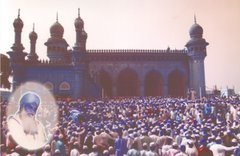

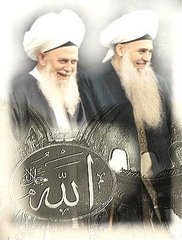

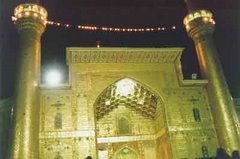

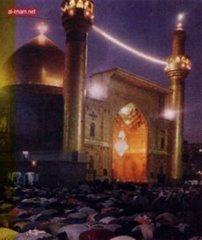

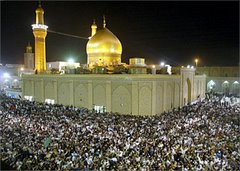




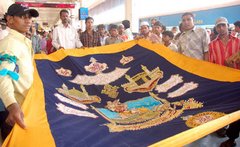
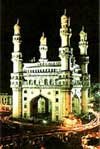



No comments:
Post a Comment